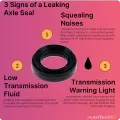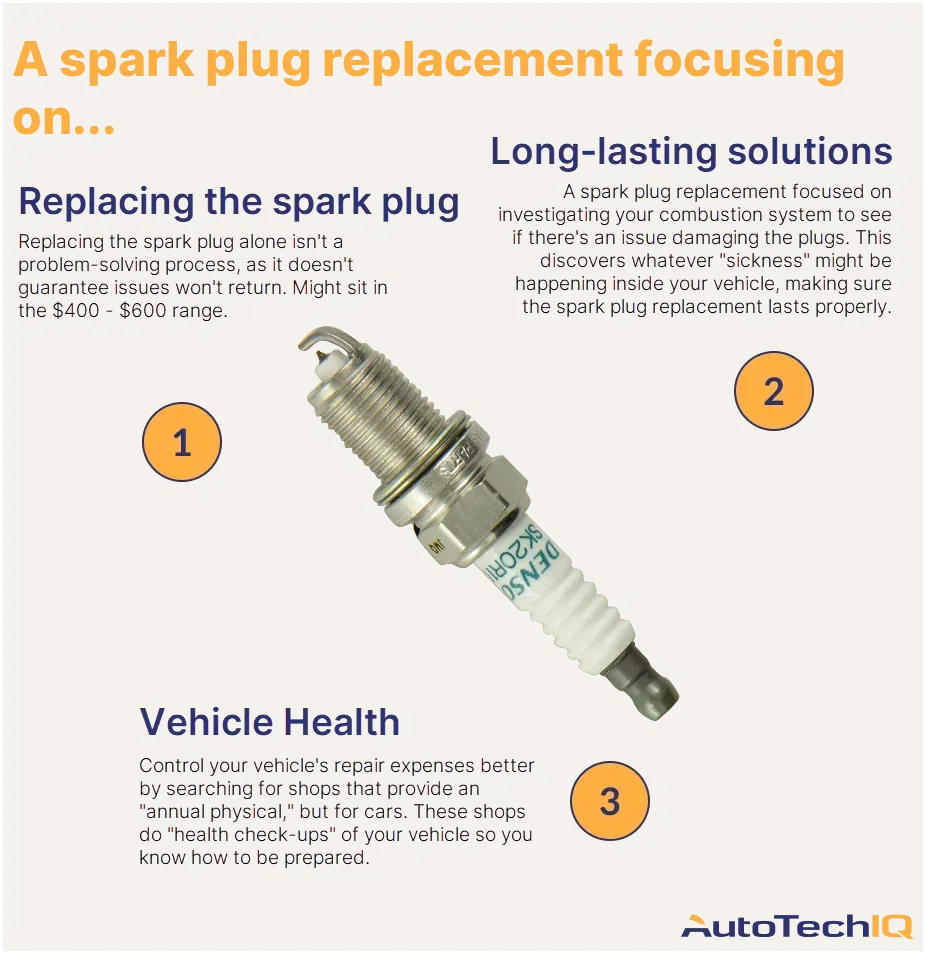
A spark plug replacement cost can range from $400 to $600.
Depending on the vehicle model, the spark plug replacement price can change. For example, the cost for a 2019 Chevrolet Tahoe might sit around $470 - $560 whereas a BMW 740i can range from $500 to $600.
Spark plug replacement cost: What affects the final price?
There are two ways a shop can quote you on a spark plug replacement. The first is quoting you only for the replacement — no discussion, inspection, or tests. The second is suggesting you do an investigation to find out if there’s a “hidden” problem in your car affecting the spark plugs.
Here are the common costs included in just the spark plug replacement:
-
The labor rate: Labor rates change between professionals (ASE technicians charge more than rookie mechanics), and regional wage differences.
-
The shop’s neighborhood/area: Areas will determine the replacement cost. For example, Santa Barbara in California has different prices than Albuquerque, in New Mexico; this could be due to lease rates, cost of living, etc.
-
The vehicle type: European brands like Mercedes, BMW, Audi, etc., have different prices for spark plug replacement. For example, a Mercedes AMG GLA-45 spark plug replacement cost can start at $400, very different from a Toyota Prius at $300.
How does the spark plug replacement return my vehicle to safety standards?
If your spark plug is bad because of regular aging, meaning nothing else was wearing it out faster than usual, then a spark plug replacement returns the vehicle to safety standards.
But, you can’t be sure if the problem won’t return without at least a combustion system inspection or engine performance testing. The inspection gives mechanics the confirmation if only a spark plug replacement takes care of everything, or if a deeper process is best.
The inspection focuses on the engine because that’s where the spark plug is.
What exactly is an engine system inspection?
The engine system inspection is a paid “detective work” where mechanics note and record everything that’s not working as expected in your combustion.
-
Mechanics inspect the vehicle, noting everything about the spark plug’s performance, and searching for any issue that could be affecting it.
-
They show you their observations and propose suggested repairs to get the spark plugs in proper condition and level.
-
They do a quote for the suggested repairs.
The proposed repair after the inspection might be just a spark plug replacement if no deeper problem is found. But, if the main problem is not just normal spark plug wear and involves other systems, the suggested quote will increase to accommodate that.
Here are the routes you can go based on your options.
-
Spark plug replacement: This means you want the spark plug replacement and nothing else, so you’ll probably only pay for common replacement and part costs. The downside is that you might not discover if anything caused the spark plug to go bad in the first place. Assume there’s a problem somewhere else in your car that’s damaging the spark plug. In this situation, a spark plug replacement won’t solve the issue, it might just make you return to the shop soon for another replacement.
-
Long-lasting fix: This means you want to permanently fix your vehicle and understand what might be wrong with it. So, you want to investigate if there’s an issue causing your spark plugs to wear out, and if there is, you want to eliminate it. You’re willing to spend more money to cover extra processes that ensure your car runs safely and reliably.
Why have a long-lasting fix? The short answer is to save money and stress while ensuring the vehicle has no issues for the next thousands of miles. A long-lasting fix has the goal of not having you return to the shop for a really long time.
The long-lasting fix is a choice that just means you want to have an investigation and get a complete solution IF there’s a deeper issue. So, for the combustion system, it doesn’t necessarily mean you’ll need to repair a bunch of engine parts; it just means you’re willing to know if faulty parts exist, if they’re related to the spark plug issue, and how to best repair them.
It boils down to it being better to be safe than sorry.
If there’s a bigger problem, how much can it change the cost of a long-lasting engine fix?
A long-lasting combustion fix has a specific track and steps that change the final price. But, it’s a bit unpredictable. Here’s what you can expect:
-
Engine system inspection: A combustion system inspection to find out if something damages your spark plugs usually costs below $200. This is an investigation of your combustion system involving the labor of service advisors and mechanics to discover issues/due repairs.
-
Component replacements: The inspection indicates any worn components in the combustion system that require replacement. This depends on the specific condition of the vehicle.
-
Other systems repairs: The shop might find other malfunctioning systems requiring parts replacements and/or computer reprogramming, affecting the cost range. In worst cases, costs can go north of $2000.
How to get transparent long-lasting repairs
If you want to:
-
Investigate what’s happening to your spark plug: Discover if something is damaging it, and if it could damage the next spark plug you replace with.
-
Fix the whole problem: If something is indeed causing contamination, fix that so it completely goes away.
-
Save time and stress: Drive with peace of mind, knowing your engine is 100% healthy and you’re far from visiting the shop because of it again.
Then, relying on online estimates is MISLEADING. Online estimates only price the spark plug replacement based on different people’s quotes, and won’t consider whether you want a long-lasting solution. The solution to your spark plug problems is specific to your vehicle.
How to spot shops that do long-lasting repairs? The best way to get a precise estimate is to seek shops with a certified “transparency process” to perform a system inspection for you.
How do these transparent shops help you budget? Basically, you’ll pay for an inspection, and get a comprehensive list of things you need to fix to keep your spark plugs in proper condition. This list will have everything you need to worry about your combustion system, even beyond spark plugs, including future recommendations and immediate suggestions.
Fortunately, these come with edited images and videos of your car so you can understand and make an informed choice of what you’ll prioritize. Prices will be clarified, so you’ll know what you spend.
The repair list is flexible, and you’ll have full control of what to do. But there’ll be a suggested repair “track” made by the service advisor to help you decide.
Let’s see an example of a transparency-focused spark plug replacement.
What does a transparent, long-lasting fix for spark plug issues look like?
A combustion system inspection is the best way to make sure a spark plug replacement is really all you need. You want to rule out if something is damaging the system, so it doesn’t damage the new spark plug you replace. Here’s what the inspection might look like.
In this case, a full combustion system inspection’s main goal is to discover the spark plug’s condition, investigate if it’s worn due to a failure in the combustion process, and check if all other components work as expected.
For instance, if a shop is requested to do a combustion system inspection due to the spark plug being faulty, the mechanics examine everything related to the system, beyond the plug itself.
They’ll check every combustion component for signs of wear, tear, or leaks to find if something is deteriorating the spark plug excessively. The inspection may reveal the need to replace various faulty components.

For example, if mechanics find oil coating the faulty spark plug, they’ll mark it as a concern point, photographing it to include in a later report. You’ll basically have the images, videos, and explanations from the expert in a file.
In this case, the mechanic investigates and finds the leaking point where the oil is coming from. Then, they’ll put the “Immediate Attention” tag on the leak point and the faulty spark plug. This means the two main priorities are to fix the oil leak and replace the spark plug.
The final quote also suggests replacing other naturally worn combustion components they’ve spotted during the inspection.
Why this level of transparency?
These businesses want to help you make the right decisions by providing education about your car so you can budget for the necessary repairs at current and future visits. It’s cost-beneficial for you and the auto repair facility.
Why is it cost-beneficial for you?
They won’t simply fix your problem. They’ll make sure it doesn’t return for thousands of miles.
Why is it cost-beneficial for them?
Most of these shops want to keep you as a customer for life. They want people to trust and recommend them, strengthening their bond with the community and growing their businesses.
The “find shops providing a DVI” method
Fortunately, you can have that level of transparency beyond the combustion system inspection. The so-called DVI method leads you to shops offering a transparent vehicle health check-up.
This method focuses on two things:
-
Does the shop have a modern DVI?
-
Does the shop have certifications?
What’s a DVI? As mentioned earlier, It’s like an annual physical visit to the doctor to assess the body’s vital signs, but for a car instead; most auto repair shops don’t charge to do it. The DVI regularly creates your vehicle’s “state of health,” explaining its overall condition.
The mechanic uses the DVI results to inform the conditions of your vehicle’s systems and the recommendations to get it running reliably. If they find issues, they’ll list them in order of priority.
Let’s see an example of how the DVI can help with a spark plug replacement:
A DVI helps with a spark plug replacement
The DVI starts with the mechanic visually checking vehicle systems (seals, bearings, connections, etc.) for signs of wear/tear/leaks. They’ll document everything through notes, videos, and pictures.
Here are some important things about a DVI:
-
It’s a visual inspection: The mechanic looks at the car’s component’s surface, searching for obvious problem signs.
-
It also checks for noises: The mechanic listens to your car sounds and searches for unusual noises.
-
It does not include further testing: A DVI doesn’t mean in-depth tests and investigations, it’s a surface-level report that indicates if a car needs repairs or deeper inspections. It's a no-tool inspection.
If they spot combustion issues, they’ll edit images and videos to indicate points of concern (damages, leaks, components’ locations, etc.) surrounding the engine. They’ll highlight their findings using arrows, circles, and text.
In the image below, the mechanic found that the spark plug was coated in oil. They photographed it and showed the customer.

A document with the vehicle’s health status is sent to the customer, with room for questions through online/phone or over-the-counter communication. The customer sees what repair priorities their vehicle has and what should be checked in the near future.
In this case, they’ll see a leak-related internal fix to prevent oil from seeping into engine components; they’ll also recommend the spark plug replacement after the leak is gone. The focus is to educate and help the customer make informed decisions about their car.
Certifications that help you
Today’s auto industry has certifications for customer-educational and transparent businesses. For example, the AutoTechIQ certification makes shops that fit into the DVI method stand out on your local map. So you can find the one closest to you.
The shops with an AutoTechIQ certification typically feature 100+ excellent Google reviews! You can quickly find this certification on a shop’s website or using AutoTechIQ’s “Find a shop” map.
FAQ on Spark Plug Replacement
How long do spark plugs last?
The lifespan of spark plugs depends on the type of plug and the vehicle, but they typically last between 20,000 to 100,000 miles. Standard copper spark plugs usually last about 20,000 to 30,000 miles, while platinum or iridium plugs, which are more durable, can last up to 60,000 to 100,000 miles. Factors such as engine type, driving conditions, and maintenance habits also play a role. For example, harsh driving conditions, poor fuel quality, or infrequent maintenance can cause spark plugs to wear out faster.
When replacing spark plugs, what else should be replaced?
When replacing spark plugs, it's a good idea to check and potentially replace other components to ensure optimal engine performance. For vehicles with individual ignition coils, consider replacing them if they show signs of wear, as old coils can lead to misfires or poor performance. If your vehicle uses traditional spark plug wires, inspect them for cracks or corrosion, and replace any that are damaged. While not always necessary, cleaning or inspecting the fuel injectors can help if you’re experiencing poor fuel efficiency or engine performance. Additionally, replacing or cleaning the air filter is beneficial for maintaining proper airflow to the engine. The PCV valve, which regulates engine pressure and reduces emissions, should also be checked, as a malfunctioning valve can lead to oil leaks or poor engine performance. If any gaskets are removed during the spark plug replacement process and show signs of wear, it’s wise to replace them to prevent leaks.
Can you drive a car with a bad spark plug?
Yes, you can technically drive a car with a bad spark plug, but it’s not advisable. A faulty spark plug can lead to several issues, such as engine misfires, rough idling, poor acceleration, and reduced fuel efficiency. If left unaddressed, a bad spark plug can cause further damage to the engine, including potential harm to the catalytic converter, which is expensive to replace. The car may also struggle to start or run poorly, especially under heavy acceleration. Driving with a bad spark plug is risky, as it can affect the car's performance and may eventually lead to more severe engine problems.
What do spark plugs actually do?
Spark plugs create a small spark that lights the air and fuel mixture inside your engine. That’s what makes your engine run. Without working spark plugs, your car would have a hard time starting, running smoothly, or even moving at all.
How do I know if my spark plugs need to be replaced?
Some common signs include:
-
Rough idling (your car shakes when sitting still)
-
Trouble starting your car
-
Poor acceleration
-
Bad gas mileage
-
Engine misfires (feels like the engine is skipping or jerking)
If you notice any of these, your spark plugs could be worn out.
How often should spark plugs be replaced?
It depends on the type of spark plugs and your car. For most cars:
-
Traditional copper spark plugs: about every 30,000 miles
-
Platinum or iridium spark plugs: about every 60,000 to 100,000 miles
Check your owner’s manual for what’s recommended for your specific vehicle.
What happens if I don’t replace bad spark plugs?
Your car can start running really poorly. It might become hard to start, stall out, burn more gas than normal, or even cause damage to other parts of the engine. Ignoring bad spark plugs for too long can lead to much bigger and more expensive problems.
How much does it cost to replace spark plugs?
It usually costs between $100 and $300 for a spark plug replacement at a shop. The price depends on how many spark plugs your car has, what type they are, and how hard they are to reach. Some cars make it really easy; others are a bit of a project.
Can I replace spark plugs myself?
If you’re comfortable working under the hood and have some basic tools, yes. For many cars, it’s a simple DIY job. But some vehicles have tricky setups where the spark plugs are hard to reach. If you’re not sure, it’s totally okay to have a mechanic do it.
Do spark plugs affect gas mileage?
Yes, absolutely. Worn-out spark plugs can make your engine burn more fuel than it needs to. Fresh spark plugs help your engine run efficiently, which means better gas mileage.
Do I have to replace all the spark plugs at once?
It’s best to replace all of them at the same time, even if only one seems bad. They all wear out around the same time, and changing them all keeps your engine running evenly and smoothly.
Is it normal for spark plugs to wear out?
Yes, it’s completely normal. Spark plugs deal with a lot of heat and pressure every time your engine runs. Over time, they naturally wear down. Replacing them is just part of regular car maintenance, like changing your oil.
How much are other repairs costing?
Other news
-
Car is Squealing When Driving
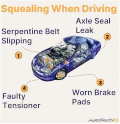
-
What is Preventative Maintenance and What Are The Benefits of it?

-
JobViewIQ - DVI Process Training - Part of the Auto Care Alliance Benefits

-
7 Signs of AC Pulley Issues
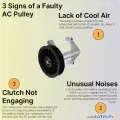
-
7 Signs of Clogged AC Components
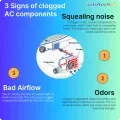
-
How Much Does a Transmission Fluid Change Cost?

-
7 Signs of a Leaking Axle Seal
